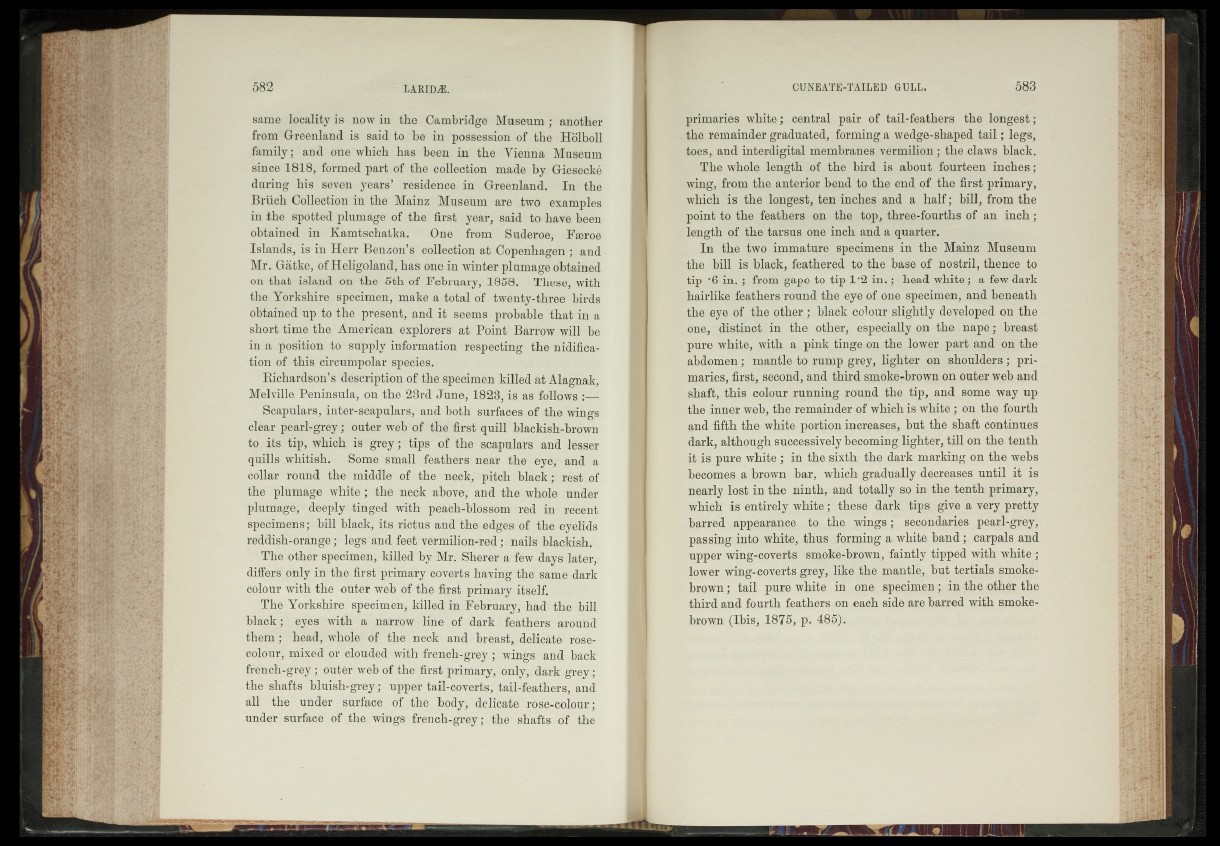
same locality is now in the Cambridge Museum ; another
from Greenland is said to be in possession, of the Holboll
family ; and. nne which has been in the Vienna Museum
since 1818, formed part of the collection made by. Giesecke
during his seven years’ residence in Greenland. In - the
Bruch Collection in the Mainz Museum are .. two examples
in the spotted plumage of the first year, said to have been
obtained in Kamtschatka. One from Suderoe,- Fseroe
Islands, is in Herr Beiizon’s collection at'/Oopenhagen ; and
Mr. Gatke, of Heligoland, has one in winter plumage obtained
on that island ■ on- the 5th of February, 1858. These, with
the Yorkshire specimen, make a total of twenty-three1 birds
obtained up to the present; and it seems . probable that in a
short time the American explorers* at Point Barrow will be
in a position to ‘ supply information respecting the nidifica-
tion of this circumpolar Specie's, •> S
Eichardson’s description of the specimen killed at Alagpak,
Melville Peninsula', on the 28rd June« 1823., is as follows :§l?
Scapulars, inter^capulars, and both surfaces of the, wings
clear pearl-grey; outer-web of the first quill 'blackish-brown
to. its tip, which is grey; tips’ oFibe;-scapulars and -lesser
quills whitish. Some'small feathers• near -the^eye,- and a
collar round th P ’riaiddle of the neck, - pitch-black1 .'rest ;©f
the plumage white; the neck above; and the whole xunder
plum'age; deeply tinged with peach-blossom red;-ft^recent
specimen^;- bfll blaek/tts/ricinis andhhe;edfe%>f the -eyelids
reddish-orange ;- 'tegs?and’ feetvermiliomred; nailsblackish.
The other specimen, killed by-Mr. Sh-erer a tew daysilater;
differs" only’ ifethe-filstprimary covert®' havihg'the' same .dark
colour with tne-' outer-web of the first primary-itsfelf. >
The Yorkshire specimen, killed in" February, had thehbil
black; ,;<|ps/-with a narrow like of ‘dark> feathhrk around
them ; head, whole* Of the-heck" and -hrefet,- delicater rose-
c’olourj' wmM orhlbuded with fr^hch%rpy; wings and fek-
french-grey- * OutoKweb ofcfhfe first primaryyr@hly;{dark>gray4:-
the shafts- bluish-gi-ey-; upper tail-coverts,; faii«feathers, and
iffi-HHe^Wder -Surface of the bodyf delicate Vose^ colour;
under surface of the wings french-grey; 'the chaffs of ~ the
primaries white ; central pair of tail-feathers the longest;
the remainder graduated, forming a wedge-shaped ta il; legs,
..toes, and interdigital membranes vermilion; the claws black.
The whole length- of the bird is about fourteen inches;
wing, from-the anterior bend to the end of the first primary,
which ( is the longest, ten-inches and a half; bill, from the
poinktq the featherss on the top, three-fourths of an inch;
length of the tarsus one inch and a quarter.
In the, two immature specimens in the Mainz Museum
the bill is black, feathered to the base of .nostril, thence to
tip ‘6 in. ; from gape to tip 1'2 in-.-;.1 head white; -a few dark
hairlike feathers round the-. eye of pne specimen, and beneath
the eye- of the other; black cqlpur slightly developed'qn the
^one,\ distinct ■ in-ihe. other, especially on thp^napqj breast
pure wh%q, with a tinge *on the lower part and on the
abdomen; mantje'tq rump grey, lighter on shoulders ; primaries,
first, second, and third smoke-brown on outer web and
shaft, this colour rnuuing.round the tip, and some way up
the-innpr web, the remainder of which is white; on the fourth
and fifth the white- portion increases, but the shaft continues
^dark, although successively becoming lighter, till on the tenth
it is pure white ; in the sixth the dark marking on the webs,
^becomes. a bro_wn -bar, which gradually decreases until it,, is
nearly lostri^the ninth,t> and to ta l^ ^q iu the tenth primary,
which is entirely, yhitg ;Jthese dark tips give a very pretty
barred appearance^o the wings; secondaries pearl-grey;
passing into white, thus tormi-ng a. white band; carpals and
upper wing-coverts smoke-brown, faintly tipped with white ;
lower wing-coverts grey,. like the mantle, but tertials smoke-
brown ; tail pure white in, .one specimen; in the other the
third and fourth feathers on each side are barred with smoke-
brown (Ibis, 1875, p. 485),. -